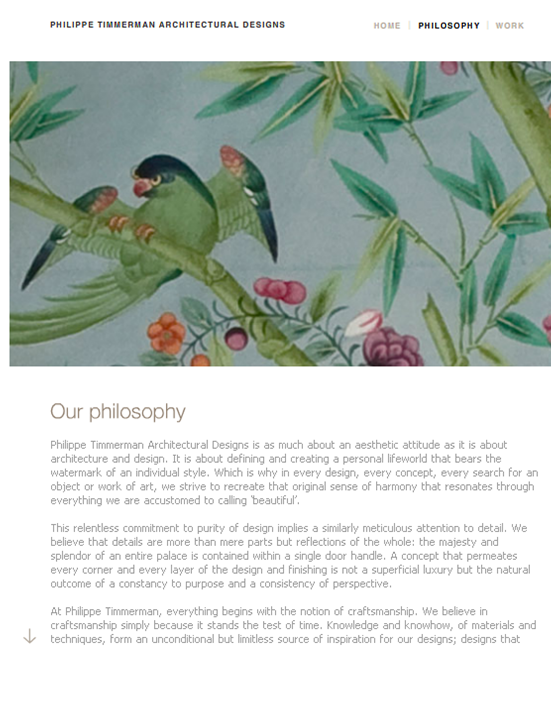-
Picking out an actual “guiding principle” (something that guides how I make
a decision) from a transcript is difficult. There is so much “brush” we need to clear away before we can see the “specimen trees” for what they are. Here is a perfect example.
It’s a page from an architecture firm’s web brochure. The page is titled “Our
philosophy.” http://www.philippetimmerman.com/ (You have to click “Philosophy”
in the navigation to get to this page.)
- “Philippe Timmerman Architectural Designs [the company] is as much about an
aesthetic attitude as it is about architecture and design. It is about defining
and creating a …” This is an explanation/description of the company’s
position in the market. - “… personal lifeworld that bears the watermark of an individual style.” This is a philosophy, “Watermark every person’s lifeworld with their individual
style.” I’m not entirely sure I understood that right–I don’t know what a lifeworld is. Nevertheless, it is how they make decisions about watermarking their designs. - “Which is why in every design, every concept, every search for an object or
work of art, we strive to recreate that original sense of harmony that resonates
through everything we are accustomed to calling ‘beautiful’.” This is an
explanation of their process, but you could pull a behavior out of it thus:
“Recreate a sense of beauty, harmony in each design, concept, and search.” It describes each employee’s intent they create their designs. - “This relentless commitment to purity of design implies a similarly
meticulous attention to detail.” This is a paragraph joiner–something that
references the first paragraph and introduces the new subject. - “We believe that details are more than mere parts but reflections of the
whole: the majesty and splendor of an entire palace is contained within a single
door handle.” This is a philosophy, “Believe details (door handle) are
reflections of the whole (palace).“ - “A concept that permeates every corner and every layer of the design and
finishing is not a superficial luxury but the natural outcome of a constancy to
purpose and a consistency of perspective.” This is also an explanation of
their process and a reassurance that the company is constant and consistent. You
might be tempted to pull “be constant and consistent” out as a guiding
principle, but that’s not how this is written. The intent it to reassure the
potential client that the company is serious. - “At [the company], everything begins with the notion of craftsmanship.” This is also an explanation of method.
- “We believe in craftsmanship simple because it stands the test of time.”
This is a statement of fact: craftsmanship stands the test of time. We [the company] agree with this fact. - “Knowledge and knowhow, of materials and techniques, form an unconditional
but limitless source of inspiration for our designs.” Here is another behavior, “Find inspiration for designs in my knowledge of materials and
techniques.” It explains the method an employee of the company follows when looking for inspiration. - “… designs that encapsulate a personal vision of the here and now, but
which also embody an orientation towards the future.” This is a statement of
fact that their designs encapsulate this orientation. - “For over time, beautiful objects gain in beauty; houses develop character;
furniture a certain patina; and works of art can but strengthen their force of
presence.” These are several statements of fact. They may say they “believe
in” these SOFs, but what do they do about them? We can’t include this set of phrases in a mental model because there is nothing here that guides a decision. (Note: Often the two words “believe in” are a red flag for something that is not really a guiding
principle.) - “[The company]’s international design office comprises a team of specialized
architects, interior decorators, designers and art historians resulting in a
dynamic exchange of ideas and perspectives.” This describes their method,
that they exchange ideas among the staff. See the next bit for the real guiding
principle. - “… synergies which form the basis of our unique vision on architecture and
design.” Well, this is not grammatically correct, but let’s go with the
flow. They are stating another behavior here, “Exchange perspectives with our
varied staff to gain unique vision.” This should definitely be included in the mental model. - “With an extensive portfolio of creations in countries such as France, Great
Britain, Monaco, Italy and the United States, [the company] continues to stamp
its mark on interior architecture in ways that are as diverse as our discerning
clientele.” This is another reassurance to potential customers, stating that
they have an extensive portfolio and discerning clients.
Tally: Two Guiding Principles
- “Watermark every person’s lifeworld with their individual style.”
- “Believe details (door handle) are reflections of the whole (palace).”
Tally: Three Behaviors
- “Recreate a sense of beauty, harmony in each design, concept, and search.”
- “Find inspiration for designs in my knowledge of materials and techniques.”
- “Exchange perspectives with our varied staff to gain unique vision.”
Put the pronoun “I” in front of each of those sentences and try them on for
size. This statements run through the minds of the employees or partners at this architecture company as they execute design work.Also note: I use the term “guiding principle” here, but also use the words “belief” and “philosophy” in other places. I mean the same thing by them: something that guides decision-making.
- “Philippe Timmerman Architectural Designs [the company] is as much about an
Picking Out Guiding Principles
Posted on | Leave a comment